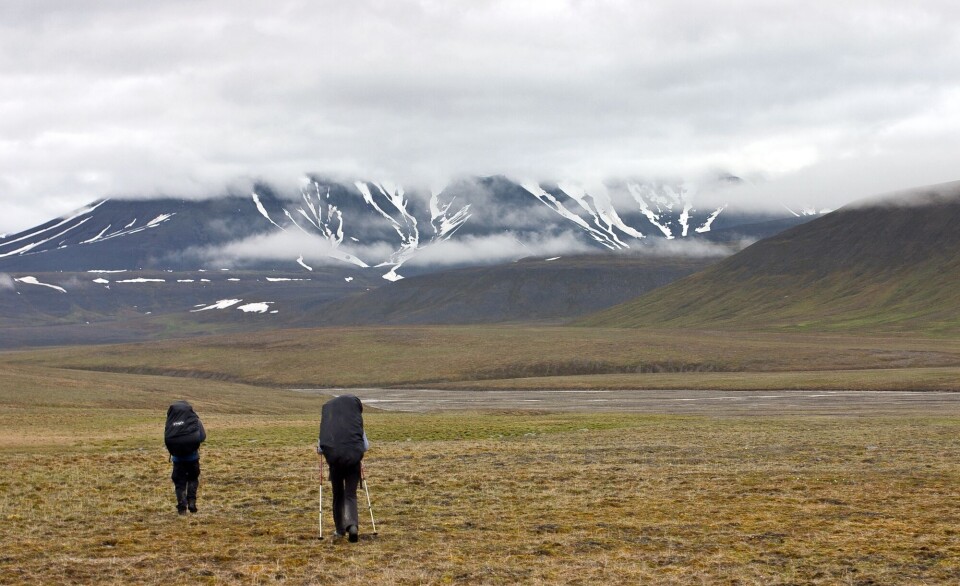THIS CONTENT IS BROUGHT TO YOU BY the Western Norway Research Institute - Read more

Restrictions and climate change: Tourism in Svalbard will change in the coming years
To protect Svalbard’s wildlife from the effects of rapid climate change, Norwegian authorities are introducing new rules and regulations that will restrict tourism in the islands.
“Global warming is unevenly distributed. The High Arctic, where Svalbard is located, is on the front line of climate change,” Halvor Dannevig says. He is a Head of Research at the Western Norway Research Institute.
The clock for warming is ticking faster in Svalbard than most other places on the globe.
From being a kind of cold desert, the archipelago is on a steady course towards a damp coastal climate where permafrost, glaciers, and sea ice play a lesser role. Already now, there is more rain, winters are warmer, and the snow season is about three weeks shorter than 30 years ago.
A climate like Denmark
In a new scientific report, Dannevig and research colleagues at the University Centre in Svalbard and Nordland Research Institute summarise how the ‘rapid and cascading’ changes in both climate and nature could affect the tourism industry in Svalbard.
The industry largely consists of offering outdoor activities in the Arctic wilderness: dog sledding, snowmobile and boat trips, summit tours, and various expeditions.
So far, tourism in Svalbard has primarily benefited from climate change. F The season for boat trips has extended because ice does not settle in the fjords as early in the autumn as it used to.
But more fundamental changes are on the way. Partly because the authorities want to protect the fragile plant and animal life against the increasing influx of tourists. And partly because climate change is transforming Svalbard into a different place than it is today.
“By the end of the century, Svalbard could have a climate similar to what Denmark has today. To what extent this will happen all depends on how well we succeed in cutting greenhouse gas emissions,” Dannevig says.
Restrictions on excursions
The first thing tourists will notice is less freedom to roam around the beautiful landscapes of the islands.
“Species that are already vulnerable can become even more vulnerable as a result of climate change, so the idea of the authorities is to reduce the human impact,” Dannevig says.

Seabirds that are already under pressure will no longer be disturbed by roaring RIBs, and calving Svalbard reindeer that are particularly sensitive to disturbances can look forward to a more peaceful existence with fewer human encounters.
The new restrictions will restrict trips based on the use of motorised vehicles, such as snowmobiles or quad bikes, which will primarily affect long-distance journeys. Tourists will also have to adjust to short excursions from Longyearbyen, the largest residential area in the archipelago.
Will not be able to disembark just anywhere
In recent years, an increasing number of tourists to Svalbard have arrived by cruise ships. Researchers describe the increase as explosive.
The small expedition ships that explore remote fjords in Spitsbergen have become particularly popular.
Last year, 25,000 visitors came to Svalbard on such vessels. Not only did the ice-free fjords provide a longer spring season; the ships were also able to enter places that were previously inaccessible because of sea ice.
“A
distinctive feature of these ships is that the passengers disembark in many
places, but the authorities will put a stop to that. In addition to fewer port calls, there will be a limit to the number of passengers a ship can carry as it enters a protected area,” Dannevig says.
Greater natural hazards
In the years to come, the authorities want any increase in tourism to take place in and around Longyearbyen instead of being distributed across the archipelago. However, there is a catch to this plan that has to do with increasing climate risk.
With more people in one place and more unstable weather, the Longyearbyen area will experience more avalanches and floods. Roads closures and evacuations will therefore occur more often and affect more tourists.
Researchers have interviewed people in the tourism sector about how they expect the predicted climate and environmental changes to affect nature-based tourism.
“More precipitation means more days with a significant or high danger of avalanches. Visitors will likely face more frequent evacuation,” Dannevig says.
Milder and shorter winters with rain in winter lead to more closed roads and routes. This hinders snowmobiles, dog sleds, and skiers through the valleys. These problems will force adaptations by those who offer adventure tourism, and not all for the better.
“When the snow disappears from the lowlands and there is less ice on the fjords, the snowmobile traffic is forced onto the glaciers. There is a greater risk of crevasses. One is also more exposed to bad weather and whiteout,” he says.
References:
Dannevig et al. Coping with rapid and cascading changes in Svalbard: the case of nature-based tourism in Svalbard, Frontiers in Human Dynamics, vol. 5, 2023. DOI: 10.3389/fhumd.2023.1178264
Dannevig et al. Impacts of climate and environmental change on tourism in Svalbard, WNRI report no 9-2023.
———
Read the Norwegian version of this article on forskning.no

This content is paid for and presented by the Western Norway Research Institute
This content is created by the Western Norway Research Institute's communication staff, who use this platform to communicate science and share results from research with the public. The Western Norway Research Institute is one of more than 80 owners of ScienceNorway.no. Read more here.
More content from the Western Norway Research Institute:
-
Your mobile phone is a climate culprit
-
1% of people cause half of global aviation emissions. Most people in fact never fly.
-
Researcher believes people should be allowed to travel abroad this summer
-
A Norwegian dilemma: Is it possible to get a second home in the mountains and maintain a clean, green conscience?



































